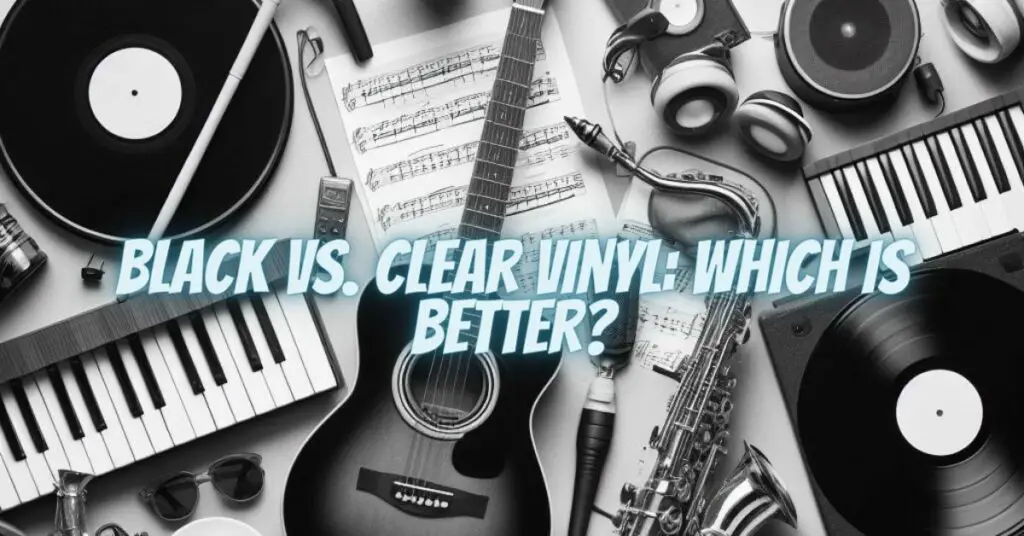Vinyl records have experienced a resurgence in popularity over the past few decades, captivating both audiophiles and music enthusiasts alike. As the demand for vinyl continues to grow, collectors and music lovers often find themselves faced with an intriguing choice: black vinyl or clear vinyl? This article aims to explore the differences between these two vinyl types, shedding light on whether one is objectively better than the other.
The Basics of Vinyl Records
Before delving into the debate of black versus clear vinyl, it’s essential to understand how vinyl records work. Vinyl records are analog audio storage mediums. Sound is etched onto the surface of the vinyl in the form of grooves, and a stylus (needle) travels through these grooves, translating the physical variations into an electrical signal that’s then amplified and sent to speakers.
The Material: Black vs. Clear
- Black Vinyl: Black vinyl is the traditional choice for most records. The color comes from the carbon black pigment used in the manufacturing process. This pigment adds weight to the vinyl, making it slightly heavier and more durable. Black vinyl is known for its classic appearance, and it has been the standard for decades.
- Clear Vinyl: Clear vinyl is a more recent development. It is made from the same polyvinyl chloride (PVC) material as black vinyl but lacks the carbon black pigment, giving it a transparent or translucent appearance. Clear vinyl is often chosen for its unique aesthetic appeal, allowing collectors to see the grooves of the record.
Sound Quality
Sound quality is a primary concern for vinyl enthusiasts. When it comes to the debate between black and clear vinyl, the general consensus among audiophiles is that there is no significant difference in sound quality between the two. The essential factor that influences sound quality is the quality of the mastering and pressing, not the color of the vinyl.
However, some claim that black vinyl might have a slight edge due to its increased weight. The added mass can reduce vibrations and resonances within the record, potentially leading to a marginally quieter and more stable playback. Nevertheless, the difference is often considered too subtle for the average listener to notice.
Visual Appeal
One area where clear vinyl undeniably shines is in terms of visual appeal. The transparent or translucent nature of clear vinyl allows for unique designs, custom artwork, and creative use of colors. Many limited edition and special release records are pressed on clear vinyl to make them visually distinctive and appealing to collectors. Black vinyl, while classic, lacks the same visual versatility.
Durability
Black vinyl is traditionally perceived as being more durable due to its higher density, primarily attributed to the carbon black pigment. However, clear vinyl has come a long way in terms of durability, and modern clear vinyl records are constructed to be just as robust as their black counterparts. The difference in longevity is negligible, and both types of vinyl can last for decades with proper care.
Collectibility and Rarity
Clear vinyl records are often considered more collectible due to their unique and eye-catching appearance. Limited edition clear vinyl releases can become highly sought after by collectors, driving up their value. Black vinyl, while classic and widely available, might not hold the same appeal in the collector’s market.
Environmental Impact
In the context of environmental concerns, it’s worth noting that clear vinyl, lacking the carbon black pigment, might be considered slightly more environmentally friendly. However, both types of vinyl have a carbon footprint in their production processes, and the environmental impact is relatively small compared to other forms of media consumption.
In the debate between black vinyl and clear vinyl, there is no definitive winner in terms of sound quality. Both types of vinyl can provide excellent audio playback. The choice between them often comes down to personal preferences, aesthetics, and collectibility.
If you value the classic and timeless look of vinyl, black vinyl may be your preferred choice. On the other hand, if you appreciate the artistic and unique designs that clear vinyl can offer, then clear vinyl might be your go-to.
Ultimately, the magic of vinyl lies in the music it holds and the experience it offers. Whether it’s black or clear, the format allows us to connect with music in a tangible and analog way, and that is something all vinyl enthusiasts can celebrate.


